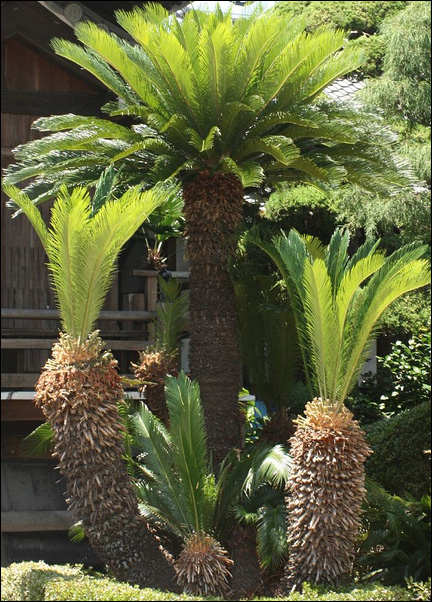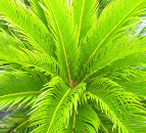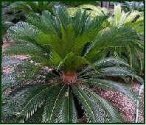Sago Palm (Cycas revoluta) Description

The Sago Palm is- While various species of Cycads can
be found throughout the world, the subtropical Sago Palm
is native to the Far East and the cold hardy Sago Palm has been used as a choice
container and landscape plant for centuries. The growth
habit of Cycas revoluta displays an upright trunk with a
diameter from 1" to 12" depending on age, topped with stiff
feather-like leaves growing in a circular pattern. Rather
than continuously adding foliage, a Sago Palm produces a periodic
"flush" of new leaves, called a "break". Eventually, offsets
begin to grow at the base of the Sago plant, and occasionally
in the crown. The addition of offsets provides a source of
new plants and many possibilities for developing an unique
specimen.
Most known cycad genus plant like the Sago palm are slow growing and have an unusual trunk. Sagos are one of the oldest cycads still living today. Sago can grow for a 100 years. They are also commonly refereed to as Cycas revoluta, King Sago Palm.
Sago Palm Care
Regardless of age or size, the Sago palms
(Cycas
revoluta) are one of the easiest plants to grow and care for, indoors or
out, by beginner or expert. Sago Palm plants adapt to a
wide range of temperatures from 15 to 110 degrees F (-11 to
42 degrees C), Sagos accepts full sun or bright interior light,
thrive with proper care and maintenance, and tolerates neglect. In addition,
Cycads are extremely long-lived. A 220 year old specimen of Encephalartos, a relative of Cycas revoluta, is on display
at the Royal Botanic Garden, Kew England; the restoration of
the famous Palm House required it to be temporarily
transplanted to a holding area for more than a year; the
move was successful and is an example of the durability of Sago Palms which are considered ancient "living fossils".
Sago Palm Leaves
On Sago Palm, new leaves emerge all at once in a
circular pattern, and are very tender until they begin to
harden several weeks later. Do not disturb or repot the
Sago Palm during this process and allow the plant to receive
good overhead light; low light will produce long leaves,
while bright light will produce shorter leaves on the Sago. If light is
coming from a window, give the Sago Palm a 1/4 turn each day
until the new leaves harden, otherwise they may lean toward
the light source. Do not allow the Cycas revoluta to become
excessively dry when new leaves are developing, otherwise
new foliage may wither and die or become yellow and
stunted. If you do not place an indoor sago plant in enough light
when it gets new leaves, they will stretch toward what
little light there is.
Sago Palms Environment
For Sago Palm temperature
range is from 15 to 110 degrees F (-11 to 42 C).
Temperatures in the high teens may frost-damage Sago Palm leaves which
may turn yellow or brown. Remove these to reduce stress on
the plant and encourage new leaves in the spring. If
temperatures fall below 15, the Sago Palm may die, however, as
long as the trunk and leaf crown is hard wood, it should
recover. If the trunk turns soft, your sago may be damaged
beyond recovery.
Sago Palm (Cycas revoluta) Specific
Humidity range is from dry to wet for Sagos.
Light: Sago Palms grow in full sun, but
adapt to outdoor shade or an indoor area which receives
bright light or a few hours of morning or afternoon sun.
The Sago Palm growth rate is extremely slow.
For example, in South Texas the fastest rate observed in commercial
production (which has excellent growing conditions of hot
summers and mild winters) under 30% shade is three new sets
of leaves and an increase of 1" (3 cm) of height and trunk
diameter per year. When grown as potted indoor specimens,
Cycads may add only one set of new leaves every year or two
and remain somewhat the same size (one reason they are
excellent for bonsai).
Sago Palm Longevity: Cycas revoluta
are extremely long lived and old specimens can grow in
curious ways. Many Sago have multi-trunks and multiple branches.
Sago Palm Soil should be well drained and rich
in humus, although these durable plants seem to grow in
almost anything. In the landscape or garden, be sure to
plant Sagos slightly above the soil line and not in a hole
or depression which retains water or is "swampy". Sago Palm much
prefer to be on the dry than the wet side.
Sago Palm Water and fertilizer needs are
related to the amount of light available. Unlike most plants
which can wilt when dry or turn yellow from lack of
fertilizer, Cycads give little indication of when to water
or feed. Generally, they should be treated as a cactus and
watered when almost dry.
Watering: If grown in a container, take care to
allow the soil to become almost dry, then water the Sago Palm thoroughly
slowly adding water around the top of the soil. If the Sago Palm is receiving morning or afternoon sun or temperatures
are warm, the Sago plant may need to be watered at least weekly.
Sagos grown in low light or cool temperatures may need
water every few weeks or so. If the cold hardy
Sago Palm is planted in the
landscape, water when dry, but do not keep continuously wet.
Established Sagos can easily survive drought conditions. |


Sago Palm - Small Palm Tree - $ 64.95
Retail Price: 77.94
You Save: $12.99

Sago Palm - Medium Palm Tree - $ 799.95
Retail Price: 959.94
You Save: $159.99
Other Cold Hardy Palms you might be interested in:
True Date Palms (Phoenix dactylifera)
(Sabal mexicana)
(Butia capitata)
(Cycas revoluta)



|








